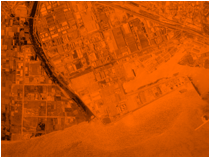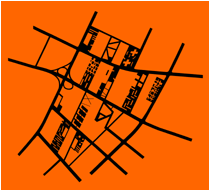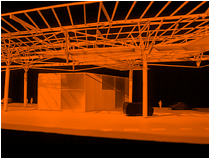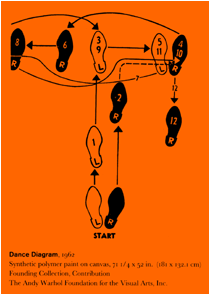
Luis
Tavares Pereira
(An)notations
Stan Allen
Logistical Activities Zone
Thomas Leeser
Architectures of Banality
(An)notations
Stan Allen
Logistical Activities Zone
Thomas Leeser
Architectures of Banality




"Logistical Activities Zone:" User´s Manual
Barcelona 1996/97
1A Surface (patches)
1. Infrastructure works not so much to propose specific buildings on given sites, but to construct the site itself. Infrastructure prepares the ground for future building, and creates the conditions for future events. Its primary modes of operation are:
1. The division, allocation and construction of surfaces
2. The provision of services to support future programs
3. The establishment of networks for movement, communication and exchange Infrastructure´s medium is geography.
patch: a nonlinear surface area differing in appearance from its surroundings.
patchiness: the density of patches, or the fineness of a mosaic.
disturbance patch: an area that has been disturbed within a matrix.
patch turnover: the rate of appearance and dissapearance of patches.
ephemeral patch: an area caused by an animal social behavior or by low-intensity, short lived fluctuations in environmental factors within a matrix.
1B Surface (matrix)
regenerated patch: an area that becomes free of disturbance within a chronically disturbed matrix
transition matrix: a table of replacement rates over a time period for all landscape elements present.
urban landscape: a landscape with a densely built-up matrix.
1C Surface (mosaic)
mosaic tract: a tract of patches of different aged trees.
shifting mosaic: a system exhibiting a pattern of long-term change along with short-term internal spatial conversions.
metastability: a state of being in equilibrium (oscillating around a central position), but susceptible to being diverted to another equilibrium.
multivariate analysis: methods that concurrently analyze many factors, plus the relationship among factors.
1D Surface (extent)
width effect: a pattern where species distributions are related to the width of a landscape element.
territorial behavior: the establishment, and usually defense, of a certain small area ("territory") against intrusions by other individuals of the same species. topological space: a map that accurately represents a spatial ordering, but is not proportional to the distance and the length of time necessary to cover a route. Also, a geometry dealing with the continuous connectedness between points of a figure.
2A Service
notations: Traditional representations presume stable objects and fixed subjects. But the contemporary city is not reducible to an artifact. The city is a place where visible and invisible streams of information, capital and subjects, interact in complex formations. They form a dispersed fireld, a network of flows. In order to describe or to intervene in this new field we need representational techniques that engage time and change, shifting scales, mobile points of view and multiple programs. In order to map this complexity, some measure of control may have to be relinquished. To open architectural representation to the score, the map, the diagram and the script could establish a basis for exchange with other disciplines such as film, music and performance. The score allows for the simultaneous presentation and interplay of information in diverse scales, on shifting coordinates and even of differing linguistic codes. The script allows the designer to engage program, event and time on specifically architectural terms. New maps and diagrams might begin to suggest new ways of working with the complex dynamics of the contemporary city.
2.Infrastructural work recognizes the collective nature of the city, and allows for the participation of multiple authors. Infrastructures give direction to future work in the city not by the establishment of rules or codes (top-down), but by fixing points of service, access and structure (bottom-up). Infrastructure creates a directional field, where different architects and designers can contribute, but it sets technical and instrumental limits to their work. Infrastructure itself works strategically, but it encourages tactical improvisation.
network circuitry: the degree to which circuit loops in a network are present.
network complexity: the combination of network connectivity and circuitry.
network connectivity: the degree to which all nodes in a system are linked by corridors.
2B Service
relative uniqueness: a measure of how many comparable examples of a characteristic exist at different levels of scale, from the local to the global.
resistance: the ability of a system, when subjected to an environmental change or potential disturbance, to withstand or resist variation.
2C Service
2.Although static in and of themselves, infrastructures organize and manage complex systems of flow, movement and exchange. Not only do they provide a network of pathways, they also work through systems of locks, gates and valves - a series of checks that control and regulate flow.
2D Service
relocation diffusion: a process by which objects leave one area and spread to another area.
expansionary diffusion: a process by which objects extend their area of coverage while continuing to occupy the original position.
proximate factor: an event or characteristic that has a direct or relatively direct effect on an organism.
3A Organization (edges+boundaries)
3. Infrastructures accomodate local contigency while maintaining overall continuity. In the design of highways, bridges, canals or aqueducts, for example, an extensive catalogue of strategies exist to accomodate irregularities in the terrain (doglegs, viaducts, cloverleaves, switchbacks, etc.) which are creatively employed to accomodate existing conditions while maintaining functional continuity. Infrasructure´s default condition is regularity - in the desert, the highway runs straight. Infrastructures are above all pragmatic. Because it operates instrumentally, infrastructural design is indifferent to formal debates. Invested neither in (ideal) regularity or in (disjunctive) irregularity, the designer is free to employ whatever works in the particular conditions.
edge effect: a distinctive species composition or relative abundance in the outer band of a patch (i.e., different from the species composition or relative abundance of the patch interior).
boundary discreteness: the degree of abruptness between landscpae elements.
boundary function: the effect of the edge on flows, analogous to a semipermeable membrane.
3B Organization (affiliation)
performance: This project marks a shift away from issues of representation to engage architecture as a material practice. Material practices, (ecology, or engineering for example) do not work primarily with images or meaning but with performance: energy inputs and outputs, the calibration of force and resistance. They are less concerned with what things look like and more concerned with what they can do. Material practices do not attempt to control or predetermine meaning. Instead, they go beyond the paradoxes of the linguistic to examine the effects of signifying practices on performance and behavior. Although these material practices work instrumentally, they are not limited to the direct manipulation of given material. Instead they project transformations of reality by means of abstract techniques such as notation, simulation or calculation.
laminar air flow: layers or streams of air moving in parallel fashion, one on top of another.
convergency point: a location where three or more types of landscape elements intersect.
convergency line: a line corridor seperating two types of landscape elements, thus providing three types in close proximity.
3C Organization (corridors + connectivity)
trip corridor: a wide band with a central interior environment that contains an abundance of interior species.
intersection effect: ecological conditions being modified significantly by the presence of an interconnection of corridors.
line corridor: a narrow band essentially dominated throughout by edge species.
corridor: a narrow strip of land that differs from the matrix on either side.
corridor filtration: selective absorption or blocking that prevents objects from crossing a corridor.
3D Organization (network)
3. Formal description of infrastructural systems: infrastructures tend to be hierarchical and tree-like, however there are effects of scale - a capillary effect when the elements get very numerous and very small - and the effects of synergy, when systems overlap and interchange, both of which tend to produce field conditions that work against an exclusively vectorial organization of infrastructural systems.
4A Structure
4. Infrastructural systems work like artificial ecologies. They manage the flows of energy and resources on a site, and direct the density and distribution of habitat. They create the conditions necessary to respond to incremental adjustments in resource availability, and modify status of inhabitation in response to changing environmental conditions.
reticulate pattern: a structure composed of linear features that interconnect and form circuits or loops. rupture point: a threshold above which a force destriys a system.
set of disturbance regimes: the intensities, frequencies, and types of perturbations (disturbances) characterizing each ecosystem type in a cluster of ecosystem types.
4B Structure
aggrading: gradually increasing in biomass or structure.
binding factors: the amounts of organic matter, acidity, and roots present that affect the aggregation of soil particles.
systems analysis: the study of the behavior of, and intersections among components in, a model of a complex system.
true synthesis: an operation in which the parts or elements of an object are transformed into new forms when combined.
4C Structure
node: a) a patch attached to a corridor, both of the same landscape element type. b) an intersection of corridors, and a source or sink of flows of objects
4D Structure
elasticity limit: a threshold of force below which a system returns to its original state and above which it is somewhat deformed.
hierarchy: a sequence of sets composed of smaller subsets.
persistence: a measure of stability, referring to the time period during which a certain characteristic continues to be present at a given level.
5A Repetition
5. Infrastructures allow detailed design of typical elements or repetitive structures, facilitating an architectural approach to urbanism. Instead of moving always down in scale from the general to the specific, infrastructural design begins with the precise delineation of specific systems within specific limits. Unlike other models, (planning codes or typological norms for example), that tend to schematize and regulate architectural form, and work by prohibition, the limits to architectural design in infrastructural complexes are technical and instrumental. In infrastructural urbanism, form matters, but more for what it can do than for what it looks like.
scending typology: a study beginning with the individual attributes and building up to the broadest groupings of them.
typology: a study of types, or a pre-classification
5B Repetition
5. The variables in organizational diagrams include formal and progrqammatic configurations: space and event, force and resistance, density, distribution and direction. Organization always implies both program and its distribution in space, bypassing conventional dichotomies of function vs, form or form vs. content. A diagram is not a thing in itself, but rather a description of potential relationships among elements.
5C Repetition
5. Unlike classical theories based on imitation, diagrams do not map or represent already existing objects or systems but anticipate new organizations and specify yet to be realized relationships. They are not simply a reduction from an existing order; their abstraction is instrumental, not an end in itself. Simplified and highly graphic, they can be loosely interpreted. They work as "abstract machines" and do not resemble what they produce.
landscape organization: the integration of structure and function, i.e., the spatial configuration and the patterns of flows in a landscape.
landscape oscillation: a regime, subject to minor environmental changes, that fluctuates but remains in equilibrium.
landscape structure: the distribution of energy, materials, and species in relation to the sizes, shapes, numbers, kinds and configurations of landscape elements or ecosystems.
5D Repetition
5. Diagrams are not "decoded" according to universal conventions; rather, the relationships are transposed - moved part by part into a new organizational context: "Whereas translation excludes all particulars in favor of a general equivalent, the transposition of media is accomplished serially, at discrete points. [...] Because the number of elements and the rules of association are hardly ever identical, every transposition is to a degree arbritrary, a manipulation. It can appeal to nothing universal and must therefore leave gaps." Friedrich A. Kittler
dispersion: the pattern of spatial arrangement of individuals, such as regular, random, or clustered. distinctive configuration: a significantly nonrandom spatial pattern
dominance: the degree to which one or a few species predominate in a community in terms of numbers, biomass, or dynamics.
6A Anticipation
6. Infrastructures are flexible and anticipatory. They work with time and are open to change. By specifying what must be fixed and what is subject to change, they can be precise and indeterminate at the same time. they work through management and cultivation, changing slowly to adjust to shifting conditions. They do not progress toward a predetermined state ( as with master planning strategies), but are always evolving within a loose envelope of constraints.
carrying capacity: the maximum number of individuals or maximum biomass that a particular environment can support
catastrophe point: a threshold at which the continuity in structure and function of a system is easily altered or broken
6B Anticipation
anticipation: Notations describe a work that is yet to be realized. Even if already performed, the work described is open to interpretation and change in the course of future performance. In this sense, notation is optimistic and anticipatory. Notation is not about interrogation, critique or commentary. These "critical" practices utilize notation´s discursive capacities only in retrospect, (pointing out what is wrong with existing reality) whereas notationŐs more radical possibility lies in the possibility of proposing alternative realities. Notation´s special properties can be expoited by the urban designer´ to produce a kind of "directed indeterminancy:" proposals that are robust and specific enough to sustain change over time, yet open enough to support multiple interpretations.
succession: a directional species replacement process, often leading though a series of recognizable stages to a climax community.
tessera: the smallest homogenous unit visible at the spatial scale of landscape.
ultimate factor: an event or characteristic, e.g., in evolution or geologic history, that causes or controls a proximate factor.
stepping stone: a spot that is colonized by a species, that is, when the species arrives and successfully reproduces and grows.
6C Anticipation
new landscape equilibrium: the condition in which a landscape subjected to severe disturbance does not return fully to its previous equilibrium level.
non-equilibrium coexistence: survival of species with irregular fluctuations because of disturbance or unpredictable (stochastic) events.
optimazation: a process of increasing effeciency or planning for increased effeciency, usually one among several characteristics.
6D Anticipation
collective: Notations presume a social context, and shared conventions of interpretation. The score is not a work itself, but a set of instructions for performing a work. A score cannot be a private language. It works instrumentally to coordinate the actions of multiple performers who collectively produce the work as event. As a model for operating in the city, the collective character of notation is highly suggestive. Going beyond transgression and cross-programming, notations could function to map the complex and indeterminate theater of everyday life in the city. The use of notation might provoke a shift from the production of space to the performance of space.
megalopolization: a process of forming a number of cities surrounded by suburbia.
species composition: the particular species present, for example in a community.
species dynamics: changes in a community due to colonization, extinction, and population size fluctuation. species source: an area (usually large) fromwhich species come in colonization.